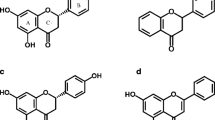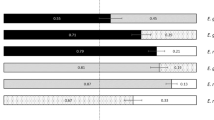Abstract
Different folivorous marsupials select their food from different subgenera of Eucalyptus, but the choices cannot be explained by known antifeedants, such as formylated phloroglucinol compounds or tannins, or by nutritional quality. Eucalypts contain a wide variety of plant secondary metabolites so it is difficult to use traditional methods to identify the chemicals that determine food selection. Therefore, we used a metabolomic approach in which we employed 1H nuclear magnetic resonance spectroscopy to compare chemical structures of representatives from the two subgenera and to identify chemicals that consistently differ between them. We found that dichloromethane extracts of leaves from most species in the subgenus Eucalyptus differ from those in Symphyomyrtus by the presence of free flavanones, having no substitution in Ring B. Although flavanoids are known to deter feeding by certain insects, their effects on marsupials have not been established and must be tested with controlled feeding studies.





Similar content being viewed by others
References
Allwood, J. W., Ellis, D. I., and Goodacre, R. 2008. Metabolomic technologies and their application to the study of plants and plant-host interactions. Physiol. Plant. 132:117–135.
Andrew, R. L., Wallis, I. R., Harwood, C. E., Henson, M., and Foley, W. J. 2007. Heritable variation in the foliar secondary metabolite sideroxylonal in Eucalyptus confers cross-resistance to herbivores. Oecologia 153:891–901.
Bick, I. R. C., Brown, R. B., and Hillis, W. E. 1972. Three flavanones from the leaves of Eucalyptus sieberi. Aust. J. Chem. 25:449–451.
Boland, J., Brophy, J. J., and House, A. P. N. 1991. Eucalyptus Leaf Oils: Use, Chemistry, Distillation and Marketing. Inkata Press, Melbourne.
Bryant, J. P., Tahvanainen, J., Sulkinoja, M., Julkunentiitto, R., Reichardt, P., and Green, T. 1989. Biogeographic evidence for the evolution of chemical defense by boreal birch and willow against mammalian browsing. Am. Nat. 134:20–34.
Conde, E., Cadahia, E., and Garciavallejo, M. C. 1997. Low molecular weight polyphenols in leaves of Eucalyptus camaldulensis, E. globulus and E. rudis. Phytochem. Anal. 8:186–193.
Diaz, P. P., Arias, T., and Josephnathan, P. 1987. A chromene, an isoprenylated methyl hydroxybenzoate and a C-methyl flavanone from the bark of Piper hostmannianum. Phytochemistry 26:809–811.
Eschler, B. M., Pass, D. M., Willis, R., and Foley, W. J. 2000. Distribution of foliar formylated phloroglucinol derivatives amongst Eucalyptus species. Biochem. Syst. Ecol. 28:813–824.
Foley, W. J., Mcilwee, A., Lawler, I., Aragones, L., Woolnough, A. P., and Berding, N. 1998. Ecological applications of near infrared reflectance spectroscopy a tool for rapid, cost-effective prediction of the composition of plant and animal tissues and aspects of animal performance. Oecologia 116:293–305.
Hellyer, R. O., and Pinhey, J. T. 1966. The structure of grandiflorone, a new β-triketone. J. Chem. Soc. C. - Organic 17:1496–1498.
Hoeck, H. N. 1975. Differential feeding behavior of sympatric hyrax Procavia johnstoni and Heterohyrax brucei. Oecologia 22:15–47.
Horn, D. H. S., and Lamberton, J. A. C. 1963. Nuclear magnetic resonance (NMR) study of a new flavonoid. Chem. Ind. (Lond.):691–2.
Hsieh, Y. L., Fang, J. M., and Cheng, Y. S. 1998. Terpenoids and flavonoids from Pseudotsuga wilsoniana. Phytochemistry 47:845–850.
Jia, Q., Nichols, T. C., Rhoden, E. E., and Waite, S. 2003. Identification of free-B-ring flavonoids as potent cyclooxygenase 2 (COX-2) inhibitors. U.S. Pat. Appl. Publ., US 2003165588 A1 20030904.
Lisec, J., Schauer, N., Kopka, J., Willmitzer, L., and Fernie, A. R. 2006. Gas chromatography mass spectrometry-based metabolite profiling in plants. Nat. Protoc. 1:387–396.
Marsh, K. J., Foley, W. J., Cowling, A., and Wallis, I. R. 2003a. Differential susceptibility to Eucalyptus secondary compounds explains feeding by the common ringtail (Pseudocheirus peregrinus) and common brushtail possum (Trichosurus vulpecula). J. Comp. Physiol. B 173:69–78.
Marsh, K. J., Wallis, I. R., and Foley, W. J. 2003b. The effect of inactivating tannins on the intake of Eucalyptus foliage by a specialist Eucalyptus folivore (Pseudocheirus peregrinus) and a generalist herbivore (Trichosurus vulpecula). Aust. J. Zool. 51:31–42.
Mayer, R. 1990. Flavonoids from Leptospermum scoparium. Phytochemistry 29:1340–1342.
Mcilwee, A. M., Lawler, I. R., Cork, S. J., and Foley, W. J. 2001. Coping with chemical complexity in mammal–plant interactions: near-infrared spectroscopy as a predictor of Eucalyptus foliar nutrients and of the feeding rates of folivorous marsupials. Oecologia 128:539–548.
Moore, B. D., and Foley, W. J. 2005. Tree use by koalas in a chemically complex landscape. Nature 435:488–490.
Moore, B. D., Wallis, I. R., Marsh, K. J., and Foley, W. J. 2004a. The role of nutrition in the conservation of the marsupial folivores of eucalypt forests. pp. 549–575, in D. Lunney (ed.). Conservation of Australia’s Forest Fauna. 2nd ed. Royal Zoological Society of New South Wales, Mosman, NSW, Australia.
Moore, B. D., Wallis, I. R., Pala-Paul, J., Brophy, J. J., Willis, R. H., and Foley, W. J. 2004b. Antiherbivore chemistry of Eucalyptus—Cues and deterrents for marsupial folivores. J. Chem. Ecol. 30:1743–1769.
Nicholson, J. K., Lindon, J. C., and Holmes, E. 1998. ‘Metabolomics’: understanding the metabolic responses of living systems to pathological stimuli via multivariate statistical analysis of biological NMR spectroscopic data. Xenobiotica 29:1181–1189.
Pannala, A. S., Chan, T. S., O’brien, P. J., and Rice-Evans, C. A. 2001. Flavonoid B-ring chemistry and antioxidant activity: Fast reaction kinetics. Biochem. Biophys. Res. Comm. 282:1161–1168.
Pass, D. M., Foley, W. J., and Bowden, B. 1998. Vertebrate herbivory on Eucalyptus—Identification of specific feeding deterrents for common ringtail possums (Pseudocheirus peregrinus) by bioassay-guided fractionation of Eucalyptus ovata foliage. J. Chem. Ecol. 24:1513–1527.
Pryor, L. D. 1959. Species distribution and association in Eucalyptus, pp. 461–471, in A. Keast, R. L. Crocker, and C. S. Christian (eds.). Biogeography and Ecology in Australia. W. Junk, The Hague.
Reichardt, P., Bryant, J. P., Clausen, T. P., and Wieland, G. D. 1985. Defense of winter-dormant Alaska paper birch against snowshoe hares. Oecologia 65:58–69.
Sarker, S. D., Bartholomew, B., Nash, R. J., and Simmonds, M. S. J. 2001. Sideroxylin and 8-demethylsideroxylin from Eucalyptus saligna (Myrtaceae). Biochem. Syst. Ecol. 29:759–762.
Scrivener, N. J., Johnson, C. N., Wallis, I. R., Takasaki, M., Foley, W. J., and Krockenberger, A. K. 2004. Which trees do wild common brushtail possums (Trichosurus vulpecula) prefer? Problems and solutions in scaling laboratory findings to diet selection in the field. Evol. Ecol. Res. 6:77–87.
Swihart, R. K., Deangelis, D. L., Feng, Z., and Bryant, J. P. 2009. Troublesome toxins: time to re-think plant-herbivore interactions in vertebrate ecology. BMC Ecol. 9:5.
Tan, C. L. 1999. Group composition, home range size, and diet of three sympatric bamboo lemur species (genus Hapalemur) in Ranomafana National Park, Madagascar. Int. J. Primat. 20:547–566.
Treutter, D. 2006. Significance of flavonoids in plant resistance: a review. Env. Chem. Lett. 4:147–157.
Veitch, N. C., and Grayer, R. E. J. 2008. Flavonoids and their glycosides, including anthocyanins. Nat. Prod. Rep. 25:555–611.
Wallis, I. R., and Foley, W. J. 2003. Independent validation of near-infrared reflectance spectroscopy as an estimator of potential food intake of Eucalyptus foliage for folivorous marsupials Aust. J. Zool. 51:95–98.
Wallis, I. R., Watson, M. L., and Foley, W. J. 2002. Secondary metabolites in Eucalyptus melliodora: field distribution and laboratory feeding choices by a generalist herbivore, the common brushtail possum. Aust. J. Zool. 50:507–519.
Whitham, T. G., Difazio, S. P., Schweitzer, J. A., Shuster, S. M., Allan, G. J., Bailey, J. K., and Woolbright, S. A. 2008. Perspective—Extending genomics to natural communities and ecosystems. Science 320:492–495.
Wollenweber, E., and Kohorst, G. 1981. Epicuticular leaf flavonoids from Eucalyptus species and from Kalmia latifolia. Z. Naturforsch., C: Biosci. 36:913–915.
Yamashita, N., Vinyard, C. J., and Tan, C. L. 2009. Food mechanical properties in three sympatric species of Hapalemur in Ranomafana National Park, Madagascar. Am. J. Phys. Anthrop. 139:368–381.
Acknowledgments
We wish to thank Cora Shiroyama for help in collecting the samples, Lynnette Lambert for assistance with 1H NMR spectroscopy and Professor Eckhard Wollenweber for valuable discussions and a generous gift of reference samples. Andras Keszei helped with the figures. The comments of three anonymous reviewers led to marked improvements in the manuscript.
Author information
Authors and Affiliations
Corresponding author
Rights and permissions
About this article
Cite this article
Tucker, D.J., Wallis, I.R., Bolton, J.M. et al. A Metabolomic Approach to Identifying Chemical Mediators of Mammal–Plant Interactions. J Chem Ecol 36, 727–735 (2010). https://doi.org/10.1007/s10886-010-9803-5
Received:
Revised:
Accepted:
Published:
Issue Date:
DOI: https://doi.org/10.1007/s10886-010-9803-5




